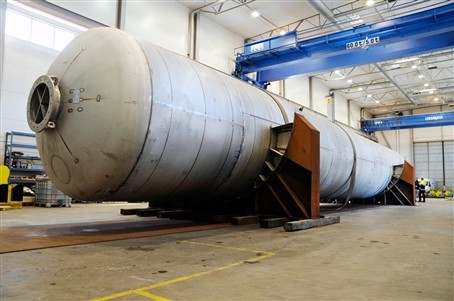Major equipment of ITER cryoplant is ready


It’s hard to miss the inner tank of ITER’s liquid helium tank even in the spacious facility where it has undergone a leak detection test. This massive piece of equipment, whose volume is 190 m3 and measures 23 m in length by 3.5 m in diameter, will store part of ITER’s liquid helium and will be assembled subsequently inside a bigger tank. The impressive size of components is one of the underlying themes of the ITER project and as you may have guessed its cryoplant will be the biggest-ever.
Manufacturing of the inner-tank started in November 2015 and was completed earlier this year. This piece of equipment stems from a lengthy process of preliminary and final design reviews where F4E, Air Liquide Global E&C Solutions, ITER International Organization, ITER India, together with independent experts, critically assessed specifications before production started. The inner-tank, designed and manufactured by CryoAB, is made of stainless steel and has multi-layer insulation to minimise any thermal losses so that the temperature inside remains at 4 K/-269 ˚C. Externally it will be covered by another component, known as a thermal shield, which will be made of aluminum and its function will be to minimise any thermal losses as well. When the tank is filled with liquid helium, its weight will reach 88 tonnes, the equivalent of 58 mid-sized cars. Now here comes a twist: after the one tank goes inside the other and the entire structure is fully assembled it will be positioned 7.6 metres high. The entire system has been designed in such way so as to cope with the potential of a seismic event.
To complete the manufacturing process of the inner-tank, it had to undergo a leak detection test. It took almost half a day for technicians and engineers to inspect 500 m of linear welds performed to join the different sectors of the tank. Representatives from F4E together with teams of Air Liquide Global E&C Solutions, witnessed the exercise managed by CryoAB and acknowledged that it was successfully completed. The equipment will arrive to the ITER site towards the end of the year.
